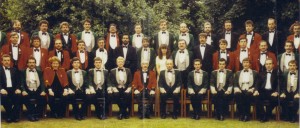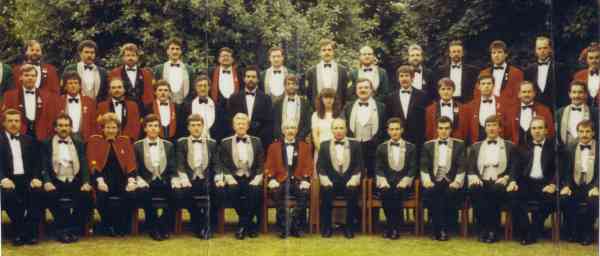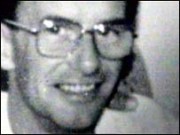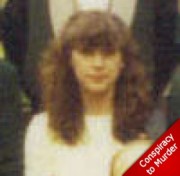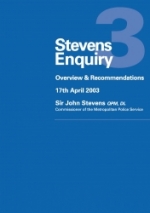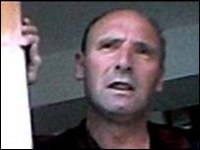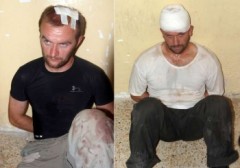The FRU: Ireland, Iraq and Libya - Britains dirty wars
 international |
crime and justice |
feature
international |
crime and justice |
feature  Thursday June 30, 2011 23:34
Thursday June 30, 2011 23:34 by indyjourno
by indyjourno
The Force Research Unit (FRU) was a covert military intelligence unit set up by the British Military of Defence sometime between 1979 and 1981. Its motto was ‘Fishers of Men’. Its remit was to recruit and run double agents in the paramilitary groups in the 6 counties. At its peak the FRU had up to 80 officers and about 100 support staff dealing with hundreds of informers. The FRU were in collusion with loyalist paramilitaries during the 1980’s and 90’s that led to the murder of dozens of catholics including high profile solicitor Pat Finucane. Despite having been exposed in British Tribunals and in the press of collusion with loyalist paramilitary gangs, a rebranded FRU has been involved in illegal operations in Iraq and Libya showing that the British establishment not only knew about the collusion but also actively encouraged it and rewarded those of its officers who were engaged in these activities.
Related Links:
South African arms |
The story of Brian Nelson |
The Stevens report (pdf) |
Gordon Kerr (times online) |
illegal surveillance operations in the Irish Republic |
Brigadier Kerr ‘led rogue spying on Russia’ |
the shooting of Jean Charles de Menezes |
The FRU were supporting loyalist paramilitaries in a number of ways. That support included the sourcing of weapons, providing intelligence, identifying targets and the facilitation of murder operations including securing restriction orders. A restriction order was where the security forces were requested to restrict patrolling or surveillance in an area over a specified timeframe. This allowed loyalist assassination squad’s ease of access to and from their targets. The FRU secured these restriction orders at weekly meetings of the Tasking and Co-ordination Group (TCG). The TCG was the liaison group for all wings of the security forces in the North of Ireland: the RUC, MI5 and the British Army. Guardian Journalist Nick Davies printed these allegations in his book Ten-Thirty-Three: The Inside Story of Britain's Secret Killing Machine in Northern Ireland. Ten-Thirty-Three, according to Davies, was the codename used for Brian Nelson the FRU’s leading loyalist agent. Although this codename is disputed by other people who say his code was Agent 6137.
Brian Nelson
Brian Nelson was a key FRU agent during the 80’s and early 90’s. He was also the UDA’s chief intelligence officer. From the Shankill Road in Belfast he was a member of the British Army prior to joining the UDA in the early 1970’s. He was jailed in 1974 after receiving a 7 year sentence for the kidnap and torture of a catholic, who was half blind, Gerald Higgins who died shortly after. In court Nelson was identified as the ringleader. He served three years in jail for this offence after which he moved to Germany, where it is claimed he was spying on the Irish community on behalf of the British Army and M16. There were 2 periods that Nelson was active in the UDA on behalf of the FRU 1983-1985 and 1987-1990 broken up by a further stay in Germany. He was re-recruited to the FRU in 1987 by Gordon Kerr the man who was to oversee the FRU in the height of their assassination campaign and who has since avoided prosecution.
In 1988 Nelson helped to organise an arms shipment from South Africa on behalf of the UDA, UVF and Ulster Resistance. On the shipment was 200 AK47 assault rifles, 90 pistols, 500 grenades, 30,000 rounds of ammunition and 12 RPG 7 rocket launchers. According to an investigation by BBC’s Panorama programme Nelsons handlers were fully aware of the shipment 2 years prior to it. Within a few years of the shipment the loyalist paramilitaries had increased their capacity to kill by over 300%. Weapons procured from that shipment have murdered over 100 people.
http://britisharmykillings.org.uk/product/96-43/South-A...-Arms
Nelsons activities were reported to the British Joint Intelligence Committee, which at the time would have been chaired by then Tory prime minister Margaret Thatcher.
Nelson was rapidly promoted to become the UDA’s chief intelligence officer for the whole of the North of Ireland. In this position the FRU refined both the UDA’s targeting and organising of the information that was supplied by RUC and UDR sources. 80 people on Nelsons files were attacked, 29 of whom died. Eventually Nelson was uncovered after the Stevens Inquiry discovered his fingerprints on security documents and he was arrested. Against the wishes of the FRU he dictated a 650 page police statement revealing the collusion of the security forces and loyalist paramilitaries. Put on trial in 1992 he pleaded guilty to 20 charges including five charges of conspiracy to murder. He was sentenced to 10 years. The trial lasted less than a day. During the trial his FRU commander Gordon Kerr testified anonymously as Colonel J praising his work and former NIO Secretary of State Tom King provided a character reference for Nelson.
Nelson served less than half of the 10 year sentence. One of Nelson’s co-handlers ‘Geoff’ attacked the sentence ” He was the jewel in the crown. I’m ashamed at the way he’s been treated by the Establishment who had used him and guided him and put him in that position. I promised Brian that the Establishment would look after him and it didn’t. It let him down and I’m ashamed of that.” Nelsons main handler in the FRU was Margaret Walshaw (Captain M) who was awarded the British Empire Medal just two weeks after Nelson was charged with offences related to Pat Finucane’s murder in 1990. The British Army promoted her to Captain in 1998. Allegations in a 2001 article in the Sunday Herald by Neil Mackay claimed ''Captain M facilitated the UDA's targeting by producing maps, photos, details of routes to the scene of the assassinations and information of targets' movements.'' http://www.iol.ie/~pfc/fru/fru23022k1a.html In 1993, the General Officer Commanding Northern Ireland, Sir John Wilsey , said he was in no way ashamed of Nelson's role: "If the Nelson episode taught us anything, it taught us that the relationship between the army and the RUC and other agencies involved was strong enough to withstand any pressures that came about because of that investigation, ". It is claimed that Nelson died of a brain haemorrhage in 2003, a claim that has been disputed by some. http://news.bbc.co.uk/2/hi/uk_news/northern_ireland/766...6.stm
Stevens Inquiry and obstructions
Former British Metropolitan Commissioner John Stevens was appointed to head up an inquiry of investigation into allegations of collusion with loyalist paramilitaries. There were 3 inquiries set up at different dates to investigate the collusion. Over the course of the 3 inquiries 9,256 statements were taken, 10,391 documents recorded (totaling over 1 million pages) and 16,194 exhibits seized. This information led to 144 arrests with 94 convictions.
The inquiry was set up after the killing of Loughlin Maginn when the UDA arrogantly produced classified British Intelligence documents that identified Maginn as an IRA Volunteer. The UDA continued to show thousands of classified documents to the media in the following months. The inquiry team had originally thought that the collusion was only the leaking of classified documents. However Nelsons arrest and confession exposed the full lengths of the FRU and British States involvement in collusion.
From the outset the investigative team were obstructed. Stevens himself reported, “Throughout my three Enquiries I recognised that I was being obstructed. Thisobstruction was cultural in its nature and widespread within parts of the Army and the RUC”
In 1990 the Stevens Inquiry headquarters in Belfast was destroyed by an arson attack. The RUC blamed the FRU in what appeared to be an attempt by the FRU to destroy evidence of collusion. However all the documents and computer files that had been destroyed had already been copied. Stevens has claimed that “This incident, in my opinion, has never been adequately investigated and I believe it was a deliberate act of arson.”
When the inquiry team tried to arrest Nelson and other loyalist paramilitaries they discovered that “There was a clear breach of security before the planned arrest of Nelson and other senior loyalists. Information was leaked to the loyalist paramilitaries and the press. This resulted in the operation being aborted. Nelson was advised by his FRU handlers to leave home the night before. A new date was set for the operation on account of the leak.”
Stevens concluded that there was indeed collusion “Collusion is evidenced in many ways. This ranges from the wilful failure to keep records, the absence of accountability, the withholding of intelligence and evidence, through to the extreme of agents being involved in murder”
http://www.madden-finucane.com/patfinucane/archive/pat_...t.pdf
Gordon Kerr: linking The FRU, Jean Charles De Menezes and Iraq
Gordon Kerr http://www.timesonline.co.uk/tol/news/uk/article859136.ece was the head of the FRU at the height of its murder campaign. Gordon Kerr, born in Aberdeen joined the Gordon Highlanders in 1970. He was first posted to the 6 counties in 1972 where he served as an undercover agent, eventually being appointed head of the FRU in 1987. It was after Kerr’s appointment as head of the FRU that increased numbers of civilians started to die at the hands of loyalist gunmen with the assistance of the security forces. As head of the FRU he ran operations that also included illegal undercover surveillance operations in the Irish 26 county state. These operations included bugging the homes of alleged republican sympathisers and a number of pubs that were believed to have been frequented by sympathisers. http://www.whale.to/b/ni2.html
The British establishment, clearly happy with the actions of the FRU during their murder campaign, awarded Gordon Kerr with an O.B.E. in recognition of ‘meritorious service in Northern Ireland’ on the 14^th of May 1991. He was also promoted to brigadier by the army on 30 June 1998 and was later appointed Britain’s military attaché in Beijing, largely to keep him away from enquiries into FRU activities being investigated by the Stevens Inquiry. His next intelligence gig, after leading the FRU, was in Germany where allegations later emerged of Kerr exceeding his authority while stationed in Berlin where he is alleged to have sent agents on unauthorised missions after Britain had agreed to stop their spying activities http://www.timesonline.co.uk/tol/news/uk/article869661.ece These claims of exceeding authority should be ignored as Kerr received future promotions to important positions in the British intelligence services, promotions that wouldn’t have been given if the British establishment weren’t happy with the work that Kerr did.
In May 2003 Kerr was sent to direct intelligence operations in Iraq and appointed head of a re-branded FRU called the Special Reconnaissance Regiment (SRR) and the Joint Support Group (JSG). The new SRR unit in what is said to have been its first operation was involved in the murder of Jean Charles De Menezes. At least one SRR officer identified the Brazilian Jean Charles De Menezes who was killed by armed police in the London underground when he was wrongly identified as possibly being one of the July 21st bombers. http://www.guardian.co.uk/uk/2005/aug/04/july7.menezes
While being led by Kerr, the unit was embroiled in further controversy in Basra when two members of the unit dressed in Arab clothes were arrested by Iraqi security forces while driving around with automatic weapons and bomb making equipment. The Iraqi security forces had arrested the men on charges of shooting 2 Iraqi policemen who challenged them while they were driving around. http://news.scotsman.com/world/British-tanks-in-smash-a...50.jp One of the Iraqi policemen died during the incident. Fattah al-Shaykh, a member of the Iraqi National Assembly claimed that the men were in “a booby-trapped car laden with ammunition” that “was meant to explode in the centre of the city of Basra” The undercover agents were freed when the jail they were being held in was attacked by 10 British tanks and helicopters that smashed down the walls of the prison to free the agents. Bizarrely the British Ministry of Defence claimed that the men were freed after negotiation, claiming the walls were destroyed “by accident”. These claims were refuted by the governor of the province Mohammed al-Waili who described the British raid as "barbaric, savage and irresponsible" and claimed "A British force of more than ten tanks backed by helicopters attacked the central jail and destroyed it. This is an irresponsible act," The Liberal Democrats spokesperson of the time Menzies Campbell claimed that Prime Minister of the time Tony Blair must have known about the attack “An operation of this kind must have gone to the highest level. I would be surprised if the Prime Minister had not been consulted.” In April 2006, the Sunday Mirror reported that the then Defence Secretary, John Reid, had ordered an inquiry into the role of Special Forces during this incident, but had been overruled. However other allegations made state that the officer appointed to examine the incident was found dead in what has been reported as suicide despite the fact that “he had displayed no signs of stress or illness and that no suicide notes were found at the scene” http://www.wsws.org/articles/2005/oct2005/basr-o21.shtml
A further link between the FRU and Iraq was made when allegations emerged that the bomb making technology used by Iraqi insurgents had originally been supplied to the Provisional IRA. http://www.independent.co.uk/news/uk/this-britain/revea....html It is alleged by FRU agent Kevin Fulton, who infiltrated the IRA, that British agents supplied the IRA with the technology so that the British Security forces “if they were intimate with the technology, then they could develop counter-measures, thereby staying one step ahead of the IRA” The IRA passed on its expertise to Palestinian groups which eventually ended up in Iraq being used against British soldiers. The British government had claimed that Iran’s Revolutionary Guard supplied the technology to Iraqi insurgents a claim that was widely reported in the media.
Brigadier J.G Kerr is alleged to have retired from the Army on 29 December 2004 when it was clear that there would be no attempt to prosecute him from the Stevens report findings.
Libya
As the bombing campaign of Libya continues it has emerged that the SRR has been active on the ground in Libya for some months now “Members of the Special Boat Service and the Special Reconnaissance Regiment are also operating behind enemy lines in Libya” special forces sources said http://www.dailymail.co.uk/news/article-1368247/Libya-S...K7nyH Early in the Libyan campaign there were a number of arrests of British operatives by Libyan rebels as they attempted to get weapons, passports and spying equipment to their agents working in Libya http://www.dailystar.co.uk/news/view/180963/SAS-blunder...-kit/ The British Foreign secretary William Hague bizarrely claimed that it was a diplomatic mission continuing Britain’s long history of attempted misinformation http://www.guardian.co.uk/world/2011/mar/07/william-hag...ssion
What is clear is that the British have no intention of changing the tactics that they learned in the North with the unit formerly known as the FRU.
It was announced in March 2009 that the SRR was returning to the North http://www.timesonline.co.uk/tol/news/uk/article5868546.ece in a move attacked by the North’s Deputy First Minister Martin McGuinness http://news.bbc.co.uk/2/hi/uk_news/northern_ireland/792....stm/
